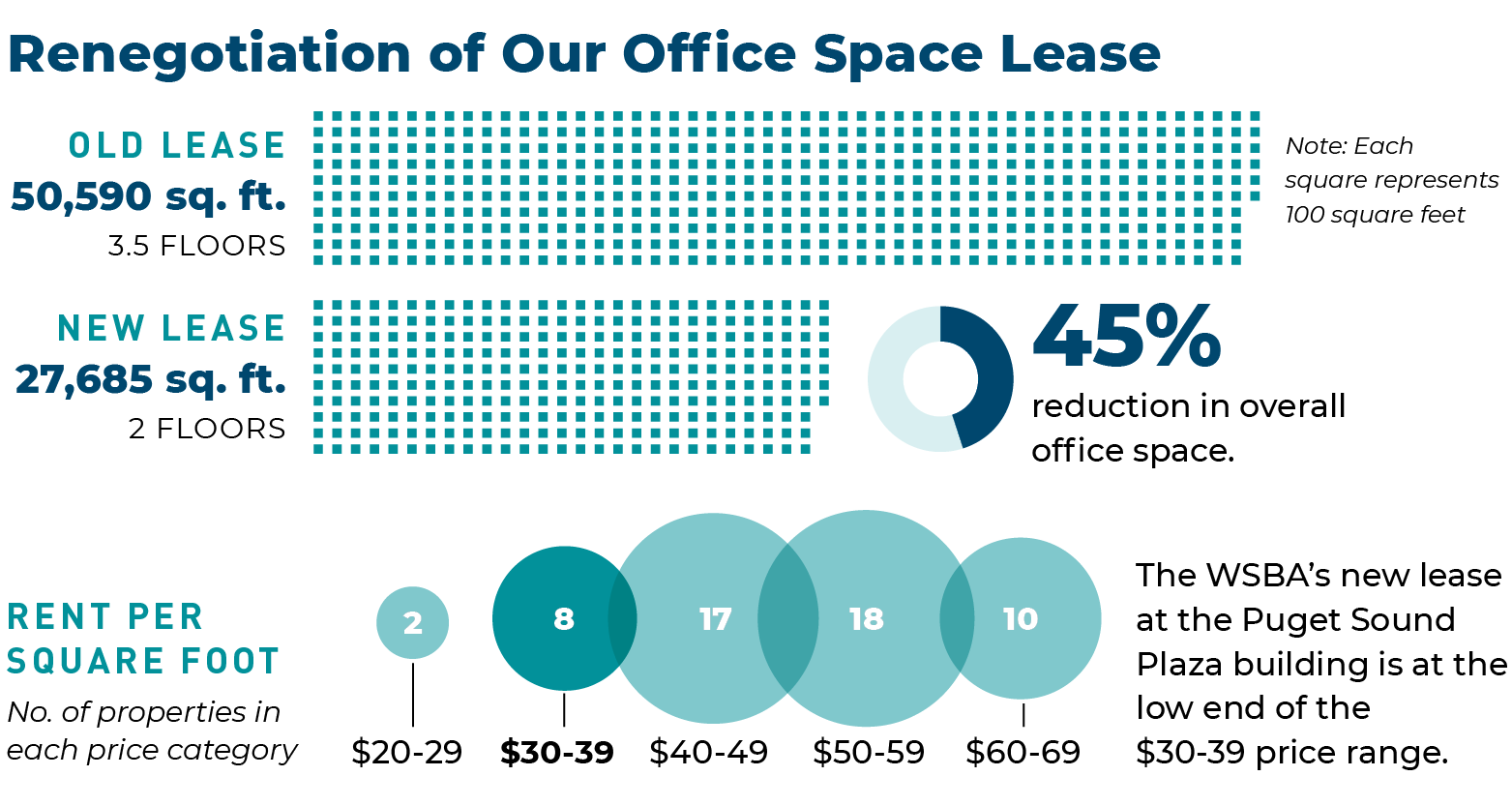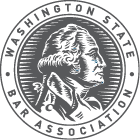Creating a Stable, Sustainable License-Fee Policy
The Board of Governors adopted this License Fee Policy in July 2025.
Respecting Our Members' Pocketbooks
WSBA leaders have made it a priority to keep license fees steady while maintaining high levels of regulatory and service standards. This year marks the sixth consecutive licensing season with no increase to the active-attorney license fee (currently $458), and that fee has risen only $9 since 2018.
How? Through a series of strategic decisions that maximized operational savings and revenue. For instance, the WSBA’s newly renegotiated office lease, with a 45% reduction in square footage, saves $900,000 per year for the next decade compared to our previous lease. We have also benefited from unexpectedly high returns on investments and careful use of reserve funds, always staying above the $2 million policy requirement.

At the same time, the complexity of the WSBA’s work continues to grow. This includes critical technology replacements and required security upgrades; complicated initiatives such as implementation of the Washington State Supreme Court’s alternative pathways to licensure as well as its new entity regulation pilot program; urgent member-driven priorities such as support for rural practitioners, member well-being, and all members navigating emerging technology; and adapting to the increasing complexity of navigating the digital world, such as tracking down metadata online as part of investigating lawyer grievances.
For years, the WSBA has been doing more with less. License fees are, by far, our primary source of revenue, and the rate of membership growth has not kept pace with the rising cost of business. Put another way: If license fees had mirrored inflation for the past decade, an active lawyer would pay $705 this renewal cycle.

A Sustainable Future
We have hit the limits of financial sustainability under this model. The question is not if the license fee will need to increase, but when and how. Toward that end, the Board has adopted a license-fee policy that will avoid steep intermittent fee hikes, allow flexibility, reflect the changing value of the dollar, and continue to respect members’ pocketbooks.
The Policy Guides Fee Setting
Under the new license-fee policy, the Board will set the license fee using three steps each year:
- Apply a market factor to the annual fee. The current year’s license fee will be adjusted using the most recent Washington Department of Labor & Industries Cost of Living Adjustment (COLA). This will ensure the license fee continues to adjust annually to reflect the actual cost of doing business to avoid a steep funding spike in future years.
- Adjust the fee to support overall programming needs and changes in membership. This includes a comprehensive analysis of expected changes in revenue and expenses for the coming year.
- Mitigate the fee through use of available reserves. The Board retains and frequently exercises its option to strategically spend down the general fund reserves to offset the license fee. This allows us to prioritize license-fee stability for members as a short-term strategy. The WSBA has a policy requirement to maintain at least $2 million in general fund reserves, and the WSBA consistently balances the need to maintain a healthy threshold above that minimum and offsetting license fees.
To understand what this policy and process looks like in practice, here’s a retroactive look at how the 2026 fee was established: The COLA for 2024-25 was 5.9%, resulting in a $27 market factor ($458 x .059); however, the Board opted to use a careful spend down of reserve funds to offset $17 of that market factor ($27-$17), leading to a final active-attorney license fee of $468 (+$10 in total) for 2026.
Resources
- Beyond a license to practice law—WSBA Benefits and Resources
- “Bar News” Graphically Speaking: Strategic Fiscal Oversight Keeps License Fees Steady
- “Bar News” Graphically Speaking: The Value of a Dollar and Creating a New License-Fee Philosophy
- “Bar News” Graphically Speaking: Infusing Ever More Value Into the License Fee
- Press release: 2025 Audit Continues Decades of “Clean” Opinions from Top Accounting Firm
Frequently Asked Questions
What benefits and resources do I get for my license fee?
A WSBA license authorizes you to practice law—and backs your license with the full slate of oversight and support necessary for a self-regulated profession, as defined by the Washington Supreme Court. Included are resources and benefits to uphold the integrity of individual practitioners and the profession—a free ethics line, legal research tool, member wellness program, and much more.
Consider this: If you attend the WSBA’s free Legal Lunchbox Series each month, you will fulfill your complete MCLE requirements each reporting cycle. Check out this: WSBA Membership: What's in It for You? fact sheet.
How does WSBA’s annual license fee compare to other jurisdictions’ rates?
It is hard to find an apples-to-apples comparison here. State bar associations vary significantly in size as well as scope; some are voluntary, meaning their state supreme court or another entity retains regulatory functions; some are mandatory but perform different ranges of regulatory services on behalf of their supreme court. Here's a chart that compares mandatory-bar license fees as well as a corresponding map and information for all jurisdictions.
Why is the WSBA headquarters in Seattle—isn’t that expensive?
The WSBA’s lease in downtown Seattle was set to expire in 2026, and leaders conducted a comprehensive statewide analysis to look at all possible options for office space that would both save money and best serve members. The unanimous decision was to consolidate floors in the current space and renegotiate the lease.
Why? The new rate is very competitive not just for the Seattle market, but for any metro area in the state, saving the WSBA almost $1 million per year compared to the previous agreement. Downtown Seattle also acts as a central hub, with public transportation options, for staff and more than 74% of WSBA state residents, who live and reside along the Puget Sound I-5 corridor (Snohomish, King, Pierce, and Thurston Counties—here’s a statewide heatmap visualization from a few years ago). Relatedly, the WSBA’s commitment to remote technology and access has greatly expanded volunteer and staff access to events, meetings, and resources. (The WSBA has staff in 11 counties across the state.)
Why is the COLA the benchmark of choice for the annual Market factor?
The cost-of-living adjustment (COLA, configured by Washington State Labor & Industries) and rate of inflation (based on the consumer price index for the Pacific Northwest area) are interrelated. The COLA is typically used to increase compensation to counteract the impact of inflation, while inflation reflects the average change in the price of goods and services over time. The WSBA Budget and Audit Committee felt that it made more sense to use the COLA as the adjustment factor, rather than inflation, because more than 80% of the WSBA’s annual budget supports staffing costs (i.e., WSBA’s work and programs are mostly all people-related and driven)—so the COLA most accurately reflects the impact of the changing value of the dollar on the WSBA’s expenses.






